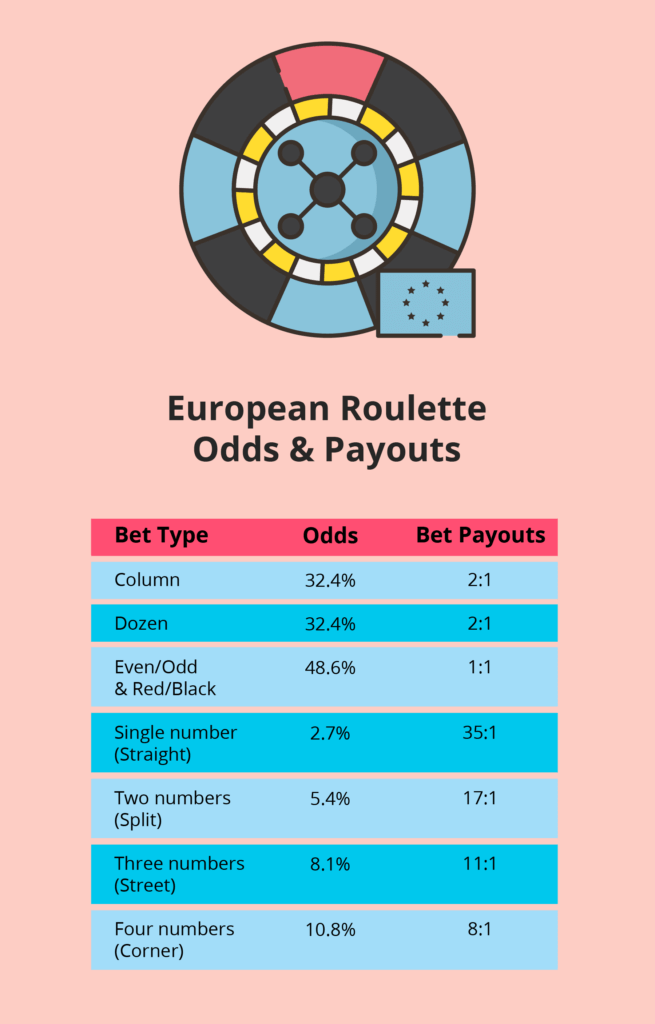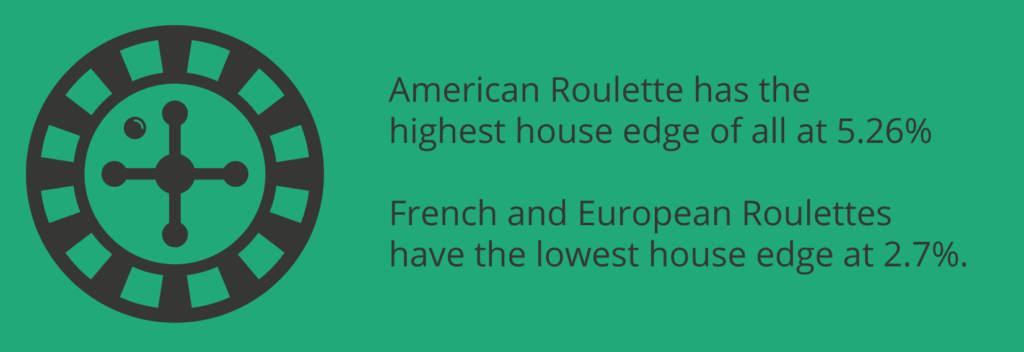Top places to play the best European Roulette
These are just a few top casinos in New Zealand picks where you’ll find European Roulette:
Master the rules & odds of European Roulette
Having the upper hand in roulette means knowing everything about its rules, bets, and odds. By understanding such important details, you can then use them to your advantage and lower the house edge.
How to win
The end purpose of roulette is to guess in which numbered space the ball will land on. Players can also make several additional roulette bets such as different colours and if the number will be high or low.

Type of bets in European Roulette
European roulette bets fall under two categories – inside and outside. Generally, inside bets are risky and have higher payouts, while outside bets are safer but with lesser payouts.
Below we have provided a closer look at inside bets for your comprehension.
Inside Bets
- Straight Up – The most inexperienced player can bet with this. It only covers one number on the roulette table and has a payout of 35 to 1
- Split Bet – By placing chips on the line between numbers, you will be betting on two numbers. The payout features a 17 to 1
- Street Bet – This bet is placed at the end of a row. It covers three numbers. Pays 11 to 1
- Square Bet – Players can place bets on the common corner of four numbers. This bet has a payout of 8 to 1
- Basket Bet – This bet is placed on the corner between 0 and 1. It covers the first row (1, 2, and 3) and 0. Has a payout of 8 to 1
- Trio – Similar to the basket bet, but only covers three numbers. You can do this by placing a bet between 1, 2, and 0 or 2, 3, and 0.
- Line Bet – Just like Street Bet, however, it only covers two lines. To wager this, place a bet at the bottom of two rows. Pays 5 to 1
Inside bets have lower odds. They can be lucrative since the payout is much higher.
Outside Bets
Outside bets carry less risk than inside bets. For this reason, they have better odds with smaller payouts. Take a look at what bets you can place:
- High/Low – Bet if the number is high (19 to 36) or low (1 to 18);
- Red/Black – Place a bet on the winning number’s colour;
- Odd/Even – Bet if the winning number is odd or even;
- Dozens – Place a bet in a dozen (1-12, 12-24 or 24-36);
- Columns – Bet on one of the three columns.
Other types of Bets
Other bets are neither classified as inside nor outside. These are the announced bets and are available in some of the European Roulette games:
- Neighbours of Zero – A bet that covers zero and seven numbers on each side, for a total of 15 numbers.
- A third of the Wheel – Covers a third of the wheel, from 27 to 33
- Orphans – Bets on the remaining numbers that are not covered by the two previous bets, for a total of eight numbers
- Zero Game – Covers zero and three numbers on each side, for a total of seven
- Neighbours – Covers a specific number and two neighbours on each side, for a total of five numbers
- Finals – With this bet, you can place a wager on the final number. For instance, if you place a Final 3 bet, you’ll be betting on 3, 13, 23, and 33
- Red/Black Split – This allows you to place bets in splits of the same colour, such as 27/30 or 18/21
RTP, payouts, and house edge in European Roulette
European Roulette is a favourite and one of the reasons is that it has one of the highest RTPs when compared to other markets. This means it has the lowest house edge, giving players the upper hand.
Take a look at the RTP rate, payouts, and house edge of the most common European roulette bets:
| Bet Type | Payout | Probability | House Edge | RTP Rate |
|---|---|---|---|---|
| Straight Up | 35 to 1 | 2.70% | 2.70% | 97.30% |
| Split Bet | 17 to 1 | 5.41% | 2.70% | 97.30% |
| Street Bet | 11 to 1 | 8.11% | 2.70% | 97.30% |
| Square Bet | 8 to 1 | 10.81% | 2.70% | 97.30% |
| Basket Bet | 8 to 1 | 10.81% | 2.70% | 97.30% |
| Trio | 11 to 1 | 8.11% | 2.70% | 97.30% |
| Line Bet | 5 to 1 | 16.20% | 2.70% | 97.30% |
| High/Low | 1 to 1 | 48.64% | 2.70% | 97.30% |
| Red/Black | 1 to 1 | 48.64% | 2.70% | 97.30% |
| Odd/Even | 1 to 1 | 48.64% | 2.70% | 97.30% |
| Dozens | 2 to 1 | 32.40% | 2.70% | 97.30% |
| Columns | 2 to 1 | 32.40% | 2.70% | 97.30% |
How does RTP work?
European Roulette has a return to player percentage (RTP) of 97.30%. This means a theoretical payout percentage of 97.30%. This means that for every $100, players can expect up to $97.30 in return over some time.
Payouts
Payouts range from 35/1 to 1/1. If you place a $1 straight-up bet, you’ll win $35. If you place a $1 odd bet, you’ll win $1.
The payouts are the same as the American version, although the odds are higher.
House edge
The house edge means the advantage the casino has over the player. For European Roulette, that edge is 2.70%. Compared to other markets, the European edge is lower. For example, the American Roulette has a house edge of 5.26%.

European Roulette vs other Roulette variants
European roulette is similar to other common roulette variants. Take a look at all the major differences below:
| Characteristics | European Roulette | American Roulette | French Roulette |
|---|---|---|---|
| Layout | 37 pockets 0 to 36 | 38 pockets 0 to 36 plus double zero (00) | Bets are spread differently across the table |
| Bets | Has special bets similar to the ones in French roulette | No special bets | Has “La Partage” and “En Prison” rules and special bets |
| RTP | 97.30% | 94.74% | 98.65% |
| House Edge | 2.70% | 5.25% | 1.35% |
European vs American Roulette
European Roulette has a few differences compared to the American version:
- Layout – The European Roulette table has 37 pockets (0 to 36), while the American Roulette table has 38 (0 to 36 plus 00)
- Bets – European Roulette features special bets (Orphans, Neighbours, etc.) that aren’t seen in the American version
- RTP and House Edge – Since the European version has fewer pockets, it has a better RTP and house edge versus the American version
English vs French Roulette
European Roulette comes from the original French Roulette game, but with time it has developed its peculiarities:
- Layout – Outside bets are all on the same side of the table in European Roulette. In the French variation, they’re spread across both sides of the table.
- Special Rules – French Roulette features “La Partage” and “En Prison” rules. These are activated once the ball lands on 0.
- La Partage – If players place an outside bet and the ball lands on 0, they get half their money back.
- En Prison – If the ball lands on 0, all bets remain in their place and are repeated within the next turn. If the player wins, his bet is returned.
- RTP and House Edge – Thanks to its unique rules, French Roulette has an RTP and house edge of 98.65% and 1.35%.
Breaking it down – How to play European Roulette
European Roulette is pretty straightforward, even for the new starters. We have prepared 4 basic steps on how to kick off your round.
- Place a bet – Select the bet you wish to perform (inside, outside, or announced bets).
- Round Begins – The game then throws the ball into the roulette wheel. During that time, the players still have time to bet.
- No More Bets – The game announces that the players can no longer bet.
- Round Ends – The ball lands in a pocket, and the players know if they won or not.
Strategies for advanced players
Though luck has its say in winning roulette, the game does offer some strategies that can help players limit losses.
We suggest that these betting systems in even bets – high/low, red/black, even/odd.
The Martingale system
The Martingale System is the most common roulette strategy. You can kick off this strategy by betting the table minimum until you lose. At your first loss, you double their bet up. If you win, you double down to the original bet.
If you lose several times in a row, you double your bet every time. Once you win, you recover the losses.
Reverse Martingale Strategy
Contrary to the Martingale System, this strategy tells you to double your bet in case of a win and halve it in a loss.
With this strategy, losing streaks won’t have much of an effect on your bankroll. This method is considered more high risk but the wins would be then more rewarding.
D’Alembert strategy
The D’Alembert Strategy is very similar to the Martingale System. But instead of doubling your bets up or down, you add or remove $1.
For example, you begin the game with a $1 wager. Then, if you win, you keep betting with $1. If you lose, you increase it by $1. If you end up losing again, you can decrease your bet by $1.
With this strategy, you can cut losses. Play safe and keep in mind that losing streaks may affect your bankroll.
Fibonacci strategy
This strategy is based on the famous Fibonacci sequence (1 – 1 – 2 – 3 – 5 – 8 – 13 – 21 – 34 – 55 – 89 – 144 – 233 – 377 – 610 – 987). Players can start at any place in this sequence. Yet, we recommend you start from 1 to have a better chance for better odds towards a positive outcome. If you lose, move to the next number. If you lose, go back to 1.
If you bet on a higher number within the mentioned sequence, there would be a need to revert to 1. You can instead move two numbers behind and start from there.
As with other strategies, losing streaks can cut your winnings.
Labouchere strategy
This strategy is more complicated than the previous roulette betting systems. It’s harder to get the hang of, but once you do, you’ll reap the rewards.
First, you need to set up a goal; let’s say you want to win $5. To do that, you need to split that number into smaller numbers. Let’s take the following example into account:
1-1-1-1-1
Take the first and last numbers and add them up. The total would be the amount you will bet. If you win, you need to cross out those numbers and the following sequence remains:
1-1-1
You then repeat this strategy over and over until you’ve run out of numbers. By this time, you’ll have accomplished your goal. However, if you lose a bet, you shouldn’t cross out any numbers.
Instead, you add your bet total to the sequence. For example, if you have lost at the previous sequence, your sequence would become:
1-1-1-2
You will see that this system will become pretty simple once you get the hang of it. Of course, it has its flaws such as the consecutive losses that will lead to long sequences. This makes it harder to cross out numbers in the long run.
Conclusion
With the insights we provided, you should be able to get started and play the world’s favourite casino game.
Though the strategies presented do not guarantee wins, you will still have the upper hand in the game. Finally, roulette is a game of chance, so there’s no foolproof strategy. Play safe.










